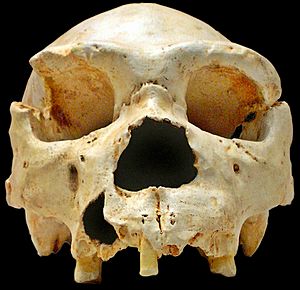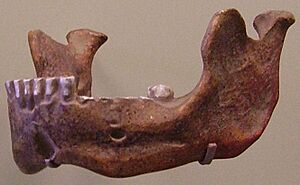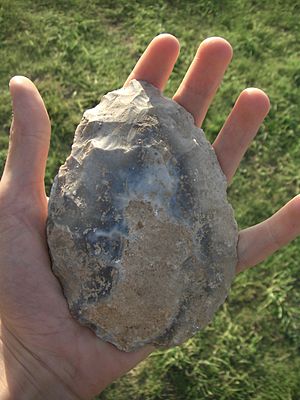Homo heidelbergensis facts for kids
Quick facts for kids Homo heidelbergensisTemporal range: Pleistocene
|
|
|---|---|
| Scientific classification | |
| Kingdom: | |
| Class: | |
| Order: | |
| Family: | |
| Genus: | |
| Binomial name | |
| †Homo heidelbergensis Schoetensack, 1908
|
|
Homo heidelbergensis was an ancient human species. Scientists often call them "Heidelberg Man." They lived long before Neanderthals. We often shorten the name to H. heidelbergensis.
Scientists are still debating if H. heidelbergensis was its own distinct species. Most of what we find are small pieces of bones. It's also hard to know their exact age. Some old books called them "early humans" or "early Homo sapiens."
We have found clear remains of Homo erectus from very early human history in Africa. We also have clear remains of Homo neanderthalensis from later times in Europe. Some experts use the name Homo heidelbergensis for human remains found between these two periods.
Contents
Discovering Homo heidelbergensis
In 1907, an archaeologist found a fossil of a lower jaw bone. This discovery happened in Mauer, near Heidelberg, Germany. Some scientists thought this jaw was so different that it belonged to a new species. They decided to name this new species Homo heidelbergensis.
Later, archaeologists found more remains in Arago, France, and Petralona, Greece. They believed these also belonged to Homo heidelbergensis. The best evidence for these early humans dates back to between 600,000 and 400,000 years ago. The stone tools used by H. heidelbergensis were very similar to the Acheulean tools used by Homo erectus.
Many scientists think Homo heidelbergensis might be the direct ancestor of both Homo neanderthalensis in Europe and Homo sapiens (modern humans). Some experts also believe that "Rhodesian Man," found in Africa, is part of the Homo heidelbergensis group.
Recent Finds of H. heidelbergensis
Scientists keep finding new clues about Homo heidelbergensis. These discoveries help us understand more about these ancient humans.
Boxgrove Man in England
In 1994, British scientists found a lower leg bone (tibia) of an early human. They found it near the English Channel at the Boxgrove Quarry site. Along with the bone, they discovered hundreds of ancient hand axes. This partial leg bone is between 478,000 and 524,000 years old.
The people who found these remains believe they are from H. heidelbergensis. However, some other scientists think they might be from early H. neanderthalensis. Before another discovery in Spain, Boxgrove was the site of the oldest human remains found in Europe.
The tibia bone showed signs of being chewed by a large carnivore. This suggests two things. The person might have been killed by an animal like a lion or wolf. Or, they might have died from another cause, and their body was eaten by a scavenger after death.
Sima de los Huesos in Spain
Starting in 1992, a Spanish team found over 5,500 human bones. These bones are at least 350,000 years old. They were discovered at the Sima de los Huesos site in the Sierra de Atapuerca, northern Spain. This pit holds fossils from possibly 28 different individuals. They also found bones of Ursus deningeri (an ancient bear), other carnivores, and a biface (a type of stone tool) called Excalibur.
Some scientists think this Acheulean axe, made of red quartzite, was a ritual offering. If true, it would be the earliest known sign of a funeral practice.
A huge number of H. heidelbergensis remains have come from this site. In fact, 90% of all known H. heidelbergensis bones are from here. The bones found in the pit include:
- A complete cranium (skull 5), nicknamed Miguelón.
- Pieces of other skulls, like skull 4, called Agamenón, and skull 6, called Rui.
- A complete pelvis (pelvis 1), nicknamed Elvis.
- Many Mandibles (jawbones), teeth, and other bones from the body. These include femurs (thigh bones), hand and foot bones, vertebrae (backbones), and ribs.
Nearby sites also contain the only known fossils of Homo antecessor.
Suffolk, England
In 2005, scientists found teeth and flint tools in the cliffs at Pakefield near Lowestoft in Suffolk, England. They also found teeth from an ancient water vole called Mimomys savini. This animal's teeth help scientists figure out the age of other species found nearby.
These finds suggest that early humans lived in England about 700,000 years ago. These humans might have been a mix between H. antecessor and H. heidelbergensis.
- Homo heidelbergensis – The Smithsonian Institution's Human Origins Program
Images for kids
-
The type specimen Mauer 1, second of two
-
Reconstructed skull of Petralona 1 at the National Museum of Natural History
-
Cast of Sima de los Huesos Skull 5 ("Miguelón") at the Natural History Museum, London
-
The speciation of modern humans and Neanderthals using the Sima de los Huesos remains
-
Cast of Kabwe 1 at the Natural History Museum, London
-
Bust of an H. heidelbergensis at the Natural History Museum, London
-
1922 restoration of a tribe of "H. rhodesiensis" by Amédée Forestier
-
Illustration of the 370,000-year-old incised elephant tibia from Bilzingsleben, Germany
-
The Sima de los Huesos hand axe 15.5 cm tall
See also
 In Spanish: Homo heidelbergensis para niños
In Spanish: Homo heidelbergensis para niños













